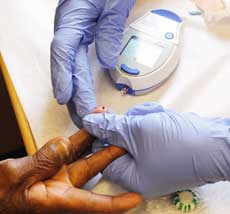fitness news
![]() ,
,![]()
Font size Diabetes
Fighting Diabetic Amputation
– Reported June 25, 2012
 PHILADELPHIA, PA ( Ivanhoe Newswire) — Worldwide, an amputation is performed every 30 seconds on a person with diabetes. Right now researchers are testing a new way to improve circulation and save limbs with a patients own cells.
PHILADELPHIA, PA ( Ivanhoe Newswire) — Worldwide, an amputation is performed every 30 seconds on a person with diabetes. Right now researchers are testing a new way to improve circulation and save limbs with a patients own cells.
Claudell Jones is diabetic, so when he started feeling pain in his feet, he got help fast. He knew his high blood sugar raised his risk for a serious infection in his foot.
“More than likely it would have spread and instead of losing the toe, I would have lost the whole leg,” Claudell Jones told Ivanhoe.
Nerve damage and poor circulation in diabetics feet can lead to ulcers. If not treated the toe, foot, or even part of the leg may have to be amputated. Claudell was lucky. Doctors were able to improve his circulation with surgery, but every year tens of thousands of diabetics lose limbs. Doctor Eric Choi from the Temples Limb Salvage Center is testing a new procedure that would give patients another option to save a foot, or leg.
“In those patients where we cannot do surgery to restore blood flow, we actually try and see if we can improve the flow by creating new blood vessels,” Eric T. Choi, M.D., FACS, an associate professor and chief of the division of vascular surgery at Temple University School of Medicine, explained.
Its called angiogenesis. Choi and his colleagues are testing a therapy that prompts the body to regrow blood vessels. Doctors extract bone marrow from a patients hip. The marrow is stimulated to produce new cells. Those cells are re-injected into patients, and create brand new vessels needed to improve blood flow. Choi says the earlier patients seek treatment, the better the outcome.
“If we can help them early, we dont have to have 150 thousand patients have foot or leg amputations,” Dr. Choi said.
A new procedure that could help diabetics like Claudell keep their limbs and quality of life. Doctor Choi says angiogenesis may increase a patients risk of developing cancer, so it may not be an option for all patients. Researchers hope to enroll six hundred people nationwide to study the therapy.